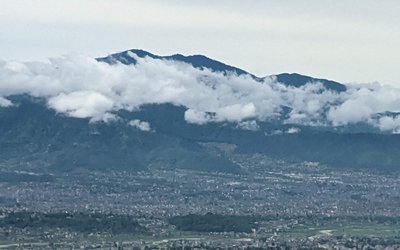Contrary to the expectation of many of us, NC president Sushil Koirala’s election as leader of its parliamentary party did not lead to a smooth and unhindered escalation to the top executive job. Not many felt that parties would succeed in electing a consensus prime minister, especially after witnessing the battle in NC and UML in electing leaders of their respective parliamentary parties, but not many imagined that it would be so difficult for Koirala to get the post, which Prachanda had proposed even prior to the dissolution of the first CA. Along with Prachanda,J N Khanal of UML and other leaders requested him to initiate necessary steps to form and lead the next government in his capacity as president of the party that had emerged victorious(number one party) in the polls to second CA.It should be interesting to recollect some of the happenings that followed Koirala’s election as leader of NC’s parliamentary party.
Expectedly, election for the post of parliamentary party leader was held in UML on February 4 in which influential leader K. P. Oli, with Bam Dev Gautam’s backing, secured 23 more votes than party chairman J. N. Khanal.This sudden change of camp by Gautam and the election result in favour of Oli brought the two together who appeared very active in matters related to government formation and other allied subjects such as election of president and vice president. The seven-point deal reached between the two major parties resolved, albeit temporarily, their differences over continuity of current president and vice president, allocated the position of CA chair to UML and ensured Koirala’s election to the post of prime minister by an overwhelming majority on February 10. These happy moments,however,did not last long for people to celebrate and rejoice over because the relations between the two parties began to sour within 24 hours of Koirala’s election basically over power sharing issue. Accusing NC of violating the agreement reached on February 9, UML not only boycotted Koirala’s oath taking ceremony but decided not to join the government. Even Subash Nembang’s election to the CA chair could not persuade UML stalwarts to join the government, which could not be expanded beyond two members for two weeks. Allocation of home portfolio remained the major bone of contention as NC wanted to keep it and UML wanted NC to honour the agreement/understanding reached between the negotiating teams of the two parties.UML made it very clear right at the outset that they wanted home portfolio to be handled by Gautam who would also lead their team in the government. Indeed, Koirala was unable to expand the cabinet due to differences with UML and his own party’s faction led by influential leader Deuba and was left with no option but to offer the home portfolio to the second largest party.This paved way for the much awaited expansion of the government including 10 ministers from each party sharing 10 ministries each. Hope the parties, mainly UML, genuinely cooperates with Koirala in giving a new constitution on time and galvanizing the sick economy. Political parties must understand that prime minister will have to step down and elections to the top jobs can be held only after the promulgation of the new constitution. Leaders, therefore, have no choice but to cooperate on the political front, which will also late the current dispensation pay some desperately needed attention to the economy.
Economy is likely to grow by about 5 percent because agriculture(explaining 35 percent of the economy) has performed well and service sector(accounting for 50 percent of gdp) has grown by 6 percent but the most discouraging aspect of our economy has been the deteriorating external sector with trade deficit increasing by 7 times in the last 9 years. In the six months of the current fiscal, imports approximated Rs.345 billion and exports totaled Rs.45 billion. Trade deficit gdp ratio that stood at 15.1 percent in fiscal 2059/60 went up to 28.2 percent in 2069/70.With gdp likely to reach Rs. 1.95 trillion (Rs.1950 billion) at current prices in 2070/71 and merchandise trade deficit expected to total Rs. 600 billion, trade deficit is likely to reach an unprecedented 30.8 percent of gdp.Export/import ratio has also fallen sharply from 40.2 to 13.8 in the last ten years and this is not likely to improve in the foreseeable future because no concrete efforts are launched to diversify production and exports. Workers’ remittance has funded swelling imports and has not contributed towards creating a sound production base that could be of help in lowering the trade gap. Production has to be diversified into nonconventional items where we have comparative advantage over other countries. It may also be noted that with India continuing to subsidize agriculture substantively, people in Nepal will continue to buy cheaper agro products from across the border. Faced with higher cost of production, even farmers in Nepal may be tempted to buy basic food items from India instead of growing them on their fields. What do we do then? In this context, one is reminded of what Bhutan, having huge trade deficit with India like Nepal, is doing to gradually correct the overall trade imbalance. Worthy of mention is the fact that Bhutan is rich in water resources (potential of generating 30000 mw power), which the country is attempting to harness with capital and technology coming from India. India accounts for 83.8 percent of Bhutan’s total trade and explains 61.5 percent of its trade deficit, while the respective figures for Nepal are 66.0 and 65.9 percent. Both the countries are heavily dependent on India for trade and concrete measures have to be taken to correct the trade imbalance. Bhutanese have realized that the total trade gap (goods and services) can be balanced only through enhanced export of power to India over time. Revenue generated through power export to India currently approximates one-third of Bhutan’s gdp.What remittance is doing in Nepal; revenue from power export is doing in Bhutan as far as their positive contribution to the current account is concerned. Nepal will have to follow more or less the same path because we cannot compete, in terms of quality and prices, with products such as garments from Bangladesh, let alone competing with products from countries such as China and India. There is no harm in buying things which are cheaper outside but Nepal has also to sell something to fund their imports. Disappointing is the fact that Nepal’s total export earning is much less than what the nation spends annually on import of petroleum products. It may be noted that reduction in central excise duty on vehicles in India is likely to increase their import to Nepal, further increasing our expenditure on petroleum import. Nepal expects lots of capital both from bilateral (such as India as the sole potential importer in dire need of energy) and multilateral sources to harness water resources, despite investment climate not looking favorable as is manifested by country’s falling economic freedom score. Small wonder real flow of foreign direct investment plunged by 65.5 percent in the first half of the current fiscal. Let us not forget that capital is in short supply globally and countries are competing with each other for it, offering different kinds of incentives related to tax, subsidy and other physical facilities. Our leaders have to realize that rampant corruption, excessive hours of power outage, nasty traffic congestion, dust-filled Kathmandu and its environs, stringent labour laws, fast depreciating national currency and double digit inflation cannot attract investors. A sincere beginning will have to be made immediately to correct these anomalies because the situation warrants launching of efforts to resolve economic and political problems simultaneously.

Dr. Tilak Rawal
Dr. Rawal is former governor of NRB.
- Chaotic Nepal -II
- Jun 23, 2025
- Six Months Of Deuba And Oli
- Jan 25, 2025
- Prachanda Outsmarted
- Jul 19, 2024
- Prachanda Outsmarts Again
- Apr 14, 2024
- Prachanda Completes One Year
- Jan 26, 2024













